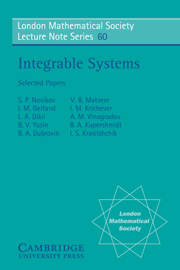Book contents
- Frontmatter
- Contents
- Introduction
- Asymptotic behaviour of the resolvent of Sturm-Liouville equations and the algebra of the Korteweg-de Vries equations (Volume 30, 1975)
- Proof of a variational relation between the coefficients of the asymptotic expansion of the resolvent of a Sturm-Liouville equation (Volume 33, 1978)
- Non-linear equations of Korteweg-de Vries type, finite-zone linear operators and abelian varieties (Volume 31, 1976)
- Methods of algebraic geometry in the theory of non-linear equations (Volume 32, 1977)
- Algebraic curves and non-linear difference equations (Volume 33, 1978)
- The structures of Hamiltonian mechanics (Volume 32, 1977)
- What is the Hamiltonian formalism? (Volume 30, 1975)
Non-linear equations of Korteweg-de Vries type, finite-zone linear operators and abelian varieties (Volume 31, 1976)
Published online by Cambridge University Press: 05 November 2009
- Frontmatter
- Contents
- Introduction
- Asymptotic behaviour of the resolvent of Sturm-Liouville equations and the algebra of the Korteweg-de Vries equations (Volume 30, 1975)
- Proof of a variational relation between the coefficients of the asymptotic expansion of the resolvent of a Sturm-Liouville equation (Volume 33, 1978)
- Non-linear equations of Korteweg-de Vries type, finite-zone linear operators and abelian varieties (Volume 31, 1976)
- Methods of algebraic geometry in the theory of non-linear equations (Volume 32, 1977)
- Algebraic curves and non-linear difference equations (Volume 33, 1978)
- The structures of Hamiltonian mechanics (Volume 32, 1977)
- What is the Hamiltonian formalism? (Volume 30, 1975)
Summary
In 1967 a remarkable mechanism was discovered relating some important non-linear wave equations with the spectral theory of auxiliary linear operators. This connection makes it possible, in a certain sense, to “integrate” these non-linear equations (see [18]). The first such equation, the famous Korteweg-de Vries (K-dV) equation, was reduced in [18] to the inverse scattering problem for the Schrödinger operator L = -d2/dx2 + u(x), to solve the Cauchy problem for the K-dV equation in the class of rapidly decreasing functions u(x). Subsequently, this mechanism was perfected and interpreted from different points of view by Lax [19], Zakharov and Faddeev [21], and Gardner [22]; later, other important non-linear equations were found to which a similar mechanism can also be applied. The first after the K-dV equation was the non-linear Schrödinger equation (Zakharov and Shabat [25], [26]) then the standard sine-Gordon equation, the Toda chain, the non-linear equation of the string, and a number of others (see [23]—[35]); for all these equations an analogue of the method of Gardner-Green-Kruskal-Miura makes it possible to “integrate” the Cauchy problem for rapidly decreasing functions of x, by means of the scattering theory for an auxiliary linear operator. In particular, this method enables us to investigate the asymptotic behaviour of solutions in time and to obtain some important particular solutions called “multisoliton”, which describe the interaction of a finite number of “solitons” (isolated waves of the form u(x — ct)).
- Type
- Chapter
- Information
- Integrable Systems , pp. 53 - 140Publisher: Cambridge University PressPrint publication year: 1981



